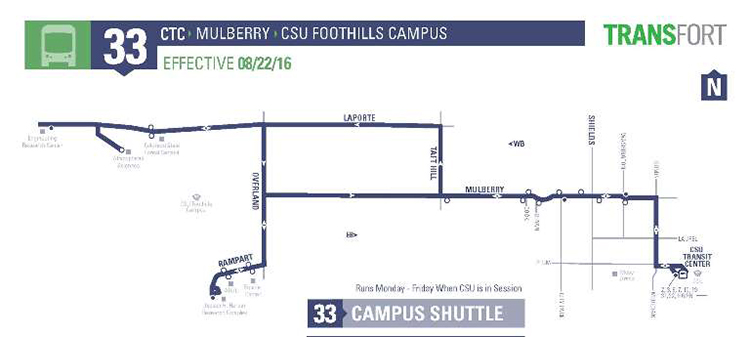2016 Announcements
December 12, 2016
Steven Brey receives Dietrich Award and Spark Student Presentation Award
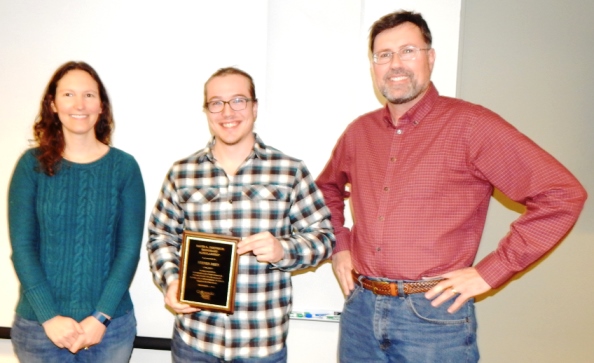
Steven Brey is presented the Dietrich Award by Air Resource Specialists representatives.
Steven also received the third place Spark Award for his presentation “There’s the smoke, where’s the fire? A regional analysis of which fires impact U.S. air quality based on a decade of HMS smoke data” at the second International Smoke Symposium in Long Beach, CA, Nov. 14-17.
November 30, 2016
ATS M.S. student Karly Reimel attends GOES-R launch


Karly’s thoughts on attending the launch:
Over the past year I have had the opportunity to create relationships with many professionals at Lockheed Martin as a result of my AMS Graduate Fellowship that was sponsored by Lockheed Martin. Through these relationships, I was given the unique opportunity to attend the launch of GOES-R and to take part in multiple events leading up to the launch. For example, I joined a group of Lockheed Martin employees in a STEM outreach event. We met with 5th and 6th graders at a local elementary school and taught them about GOES-R and its applications. I gave a presentation on lightning and how the Geostationary Lightning Mapper (GLM) onboard GOES-R will be important for future work in atmospheric science. The students took great interest in learning about weather and asked many fantastic questions. We also helped the students create cup-anemometers out of recycled materials. It was incredible to see the joy on their faces as they successfully constructed their own weather instruments. After helping with the STEM event, I had the opportunity to see the GOES-R launch vehicle up close by attending a photo-op event.
The following day, I witnessed the launch from Kennedy Space Center in the Banana Bay area with my father. The Saturn V building was opened to the public, so prior to the launch of GOES-R we were able to go and marvel in the size and importance of this rocket to America’s quest to land on the moon. The launch viewing area looked out over the bay and you could see the launch vehicle in the distance. Audio updates from the control center along with the countdown to launch were played over loud speakers. The initial launch time was set to 5:42PM EST. Due to various problems discovered while preparing for the launch, the launch time was pushed further and further back until it reached the final time in the launch window. You could feel the tension in the air as everyone waited to hear if we would be witnessing the launch that day. Thankfully no other problems were reported and GOES-R was successfully launched at 6:42PM EST.
Witnessing this event was a truly indescribable experience. As the countdown reached one, the entire sky lit up and the rocket moved upward in a ball of light. I had almost forgotten that a launch makes sound until the sound waves came roaring through a while after the rocket had already become airborne. It was a surreal moment to realize that GOES-R was finally on its journey to geostationary orbit.
Thankfully everything has gone as planned thus far and hopefully we will have new and exciting data to work with in the very near future. GOES-R data and the Geostationary Lightning Mapper will be used in my M.S. thesis research that I am doing with my co-advisors, Prof. Steven Rutledge and Dr. Steven Miller.
November 28, 2016
Prof. Emily Fischer making PROGRESS, supporting women in geosciences

In fall 2014, a professional development and mentoring network for undergraduate women studying geosciences called PROGRESS was launched at Colorado State University.
Supported by a $1.7 million National Science Foundation award, Emily Fischer, assistant professor of atmospheric science, and co-investigators from CSU, Colorado College and West Virginia University welcomed their first group of students in 2015. PROGRESS (Promoting Geoscience Research, Education and Success) has since rolled out both on the Colorado Front Range and in the Carolinas. In October, Fischer and collaborators welcomed their second cohort of about 90 undergraduate women.
“We’re testing whether this type of program is sustainable in different regions, and whether this is a feasible model for undergraduate women,” Fischer said.
PROGRESS is inspired in part by the Earth Science Women’s Network, an international organization that provides career and community support for its 2,500 members in 50 countries. Its member base is primarily made up of graduate-level or higher women, however.
Fischer started PROGRESS with Melissa Burt, Diversity Initiatives Manager for the College of Engineering. They wanted to create a program that would open up valuable professional development opportunities to undergraduate women in the geosciences.
Along the Front Range, participating universities in PROGRESS are Colorado State University, University of Colorado Boulder, Metropolitan State University of Denver, Colorado College and University of Wyoming. Participating Carolina universities are North Carolina Agricultural and Technical State University, University of North Carolina at Charlotte, North Carolina State University and University of South Carolina.
Building community with other women
PROGRESS begins with a weekend workshop that introduces participants to the environmental and earth sciences and shows them examples of diverse women working and succeeding in these fields. A focus of the program is mentoring, and students also learn about the value of mentoring and how to build networks.
“Students really like the workshop, and for some, it’s this moment when they were kind of lost, or ready to change their major, but coming to the workshop provided a community and gave them the energy to realize that this is something they can do,” Fischer said.
During the weekend workshop, students also are paired with more senior women who serve as long-term mentors. Student-mentor pairs are encouraged to meet several times each semester, as well as attend PROGRESS-hosted networking events on each participating campus.
“Through mentoring, our goal is to provide students with support and positive affirmations, especially during their first semester,” Fischer said. Networking events are open to all PROGRESS participants and are meant to facilitate engaging, fulfilling, and overall meaningful relationships for students.
ESWN members pay it forward
Many of the women serving as PROGRESS mentors are also current members of ESWN.
“We’re excited about creating this engaging, supportive, and comforting environment that we’ve been able to experience, but at a graduate level,” Fischer said. The women involved are inspired to give back to undergraduates because of the support they’ve experienced through ESWN.
ESWN members also have experienced firsthand the challenges of working in the geosciences, and hope that early exposure to the sciences will help undergraduate students realize these fields are societally relevant.
Though women continue to be largely underrepresented in the geosciences, the hope is that mentoring and community building can help close that gap. The effort follows a decade of successful diversity-related efforts in the Department of Atmospheric Science.
Interested in becoming involved with PROGRESS, either as a mentor or a participant? Contact Emily Fischer at Emily.V.Fischer@colostate.edu. Additional resources for women interested in the earth and environmental sciences are available on the PROGRESS website.
November 18, 2016
Prof. Jeff Pierce’s group demonstrates how seabirds impact Arctic aerosols and climate

It turns out bird poop helps cool the Arctic.
That’s according to new research from Colorado State University atmospheric scientists, who are working to better understand key components of Arctic climate systems.
Publishing in Nature Communications and featured by the American Association for the Advancement of Science, Associate Professor of Atmospheric Science Jeff Pierce and graduate student Jack Kodros present evidence linking ammonia emissions from summertime Arctic seabird-colony excrement, called guano, to newly formed atmospheric aerosol particles. These particles can in turn influence Arctic cloud properties and their effects on climate.
Clouds and climate
Clouds play a key role in modulating Arctic temperature; thus, understanding factors that influence clouds is essential, Pierce says. Central to the development of clouds is the availability of cloud condensation nuclei – small atmospheric particles around which water can condense.
Using a combination of observations and computer modeling, Pierce, Kodros and co-authors at Dalhousie University, University of Toronto, and Environment and Climate Change Canada determined that migratory-seabird colonies have a definitive influence on atmospheric particles and clouds in the pristine summertime Arctic.
They report the presence of summertime bursts of atmospheric particles linked to ammonia emissions from seabird-colony guano. These particles can spread throughout the Arctic, fostering cloud-droplet formation, and in turn reflect sunlight back to space for a net cooling effect.
“This newly identified and fascinating ecological-atmospheric connection highlights the interconnectedness of the many components of Earth’s climate system,” Pierce said.
November 14, 2016
CSU Cans Around the Oval wraps up donation drive
Thank you all very much for your participation in this year’s Cans Around the Oval Food Drive! All told, the university collected 41,670 pounds of food and $57,714 in cash donations to feed hungry families in Larimer County. As a department, ATS collected 72 pounds of food and $415, for a total “impact factor” of 2,147 pounds! Your generosity is much appreciated! – FORTCAST Executive Board

November 10, 2016
ATS and CIRA make strong showing in College of Engineering awards

ATS and CIRA made a strong showing at the Nov. 10 College of Engineering awards ceremony. From left to right: ATS alum and CIRA Associate Director Dr. Steve Miller received the Outstanding Administrative Professional Staff Research Award. Prof. Libby Barnes was recognized with the COE Abell Outstanding Early-Career Faculty Award. Department Head and Prof. Jeff Collett received the Abell Outstanding Research Faculty Award.
November 9, 2016
Sjostrom Family and Shrake-Culler scholarships awarded to Zitely Tzompa and Chengji Liu


Zitely Tzompa and Chengji Liu have been selected to receive, respectively, the Sjostrom Family Scholarship and the Shrake-Culler Scholarship.
The Sjostrom Family Scholarship is awarded annually to a graduate student in a CSU College of Engineering Department. This year applications were invited from ATS students. Preference is given to students who have a demonstrated research and/or professional interest in improving the quality of life in less industrialized communities.
The Shrake-Culler Scholarship is awarded annually to an ATS Ph.D. student. Students are selected based on a strong research and academic record and demonstration of a strong work ethic and enthusiasm for higher education.
Congratulations to Zitely and Chengji on their selection for these awards!
November 5, 2016
Friends, colleagues and family celebrate University Distinguished Professor Emeritus Tom Vonder Haar’s retirement

Prof. Tom Vonder Haar receives retirement gift

Friends, colleagues and family celebrated University Distinguished Professor Emeritus Tom Vonder Haar’s retirement on Sept. 10, 2016. Prof. Emeritus Vonder Haar served on the ATS faculty for 46 years, including as Department Head (1974-84) and Founding Director of CIRA (1980-2008). He has enjoyed advising approximately 30 Ph.D. and 100 M.S. graduates from the department.
November 1, 2016
Professors Sue van den Heever and Eric Maloney receive 2016 Atmospheric Sciences Ascent Award


Two CSU ATS faculty members were recently announced as winners of the 2016 Ascent Award from the Atmospheric Science section of the American Geophysical Union. The awards will be presented at the AGU fall meeting, to be held Dec. 12–16 in San Francisco, CA.
Monfort Professor Sue van den Heever was selected for this distinguished recognition by AGU for fundamental advances to our understanding of the influence of microphysical processes on atmospheric convection, and feedback processes.
Professor Eric Maloney was selected for this distinguished recognition by AGU for fundamental studies enhancing the understanding of the Madden and Julian Oscillations, and their impacts on a wide range of tropical phenomena including tropical cyclones.
The Ascent award recognizes exceptional research and professional leadership by mid-career scientists working in the atmospheric and climate sciences. Five Ascent award winners were named this year: three from the U.S., one from England, and one from Australia. The award announcement was made in the October AGU publication, EOS.
Congratulations Profs. van den Heever and Maloney on this outstanding achievement!
More information: ARM/ASR Veteran Researchers Win American Geophysical Union Ascent Awards
Citation: AGU (2016), Hall, Jakob, Maloney, Scaife, and Van den Heever receive 2016 Atmospheric Sciences Ascent Award, Eos, 97, doi:10.1029/2016EO060625. Published on 10 October 2016.
October 10, 2016
2016-17 MAC Student Travel Award recipients announced

Pictured left to right: Aryeh Drager, Veljko Petkovic, Dakota Smith, Bryan Mundhenk, Ali Akherati, Marie McGraw and Peter Marinescu
The MAC Student Travel funding committee is pleased to announce the following winners of the 2016-17 MAC Student Travel Awards:
| Student | Advisor | Conference |
| Ali Akherati | Shantanu Jathar Mech. Eng. | American Association for Aerosol Research |
| Aryeh Drager | Sue van den Heever | AMS 17th Conference of Mesoscale Processes |
| Peter Marinescu | Sue van den Heever and Sonia Kreidenweis | 2017 Aerosol, Clouds, Precipitation and Climate Working Group Meeting |
| Marie McGraw | Elizabeth Barnes | AMS 21st Conference on Atmospheric and Ocean Fluid Dynamics |
| Bryan Mundhenk | Elizabeth Barnes and Eric Maloney | Sub-Seasonal to Seasonal Predictability of Extreme Weather and Climate Workshop |
| Veljko Petkovic | Christian Kummerow | NASA’s Precipitation Measurements Missions Science Program Team Meeting |
| Dakota Smith | Scott Denning | 97th American Meteorological Society Annual Meeting |
The MAC Student Travel Awards are supported by the MAC Foundation in Fort Collins, CO, where ATS Emeritus Professor Thomas McKee serves as a Foundation Trustee. The MAC Foundation provided a generous donation to the ATS department to support student travel to attend and present at conferences and meetings related to atmospheric science.
October 4, 2016
Prof. Tom Vonder Haar selected as AMS Honorary Member
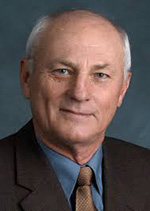 University Distinguished Professor Emeritus Tom Vonder Haar has been selected as an Honorary Member of the American Meteorological Society. Tom will be recognized at the AMS annual meeting in Seattle in January.
University Distinguished Professor Emeritus Tom Vonder Haar has been selected as an Honorary Member of the American Meteorological Society. Tom will be recognized at the AMS annual meeting in Seattle in January.
Honorary Member is a special title reserved for those “persons of acknowledged preeminence in the atmospheric or related oceanic or hydrologic sciences.” According to the AMS, “Fellows should have made outstanding contributions . . . during a substantial number of years. Honorary Membership is meant to delineate and to acknowledge a rarer distinction, comparable to or exceeding that demanded by the Society’s highest awards.”
Tom’s selection as AMS Honorary Member places him in a select group of distinguished individuals who have made exceptional contributions to the atmospheric and related sciences. Congratulations, Tom!
October 1, 2016
Welcome new ATS faculty Michael Bell and Kristen Rasmussen!
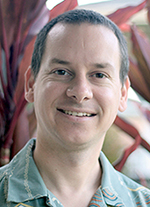 Professor Michael Bell joined the CSU Atmospheric Science faculty as an Associate Professor in August 2016.
Professor Michael Bell joined the CSU Atmospheric Science faculty as an Associate Professor in August 2016.
Michael received his B.S. in Applied Mathematics with a minor in Meteorology at Metropolitan State College of Denver in 2001. He completed his M.S. in 2006 from the Department of Atmospheric Science at Colorado State University and Ph.D. in Meteorology in 2010 from the Naval Post Graduate School. Michael was an assistant professor at the University of Hawaii at Manoa from 2012 to 2016 prior to joining the CSU ATS faculty.
Michael’s primary interests are in tropical, mesoscale and radar meteorology. A central focus of his research is studying the mesoscale structure and intensification of tropical cyclones throughout their life-cycle from genesis to extratropical transition. This research is accomplished through the collection and analysis of research quality observations from aircraft and Doppler radars, in conjunction with high-resolution numerical modeling. A significant component of his research effort also is aimed at improving mesoscale and radar analysis techniques and open source software tools.
Professor Kristen Rasmussen joined the CSU Atmospheric Science faculty as an Assistant Professor in October 2016.
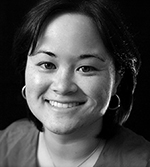 Kristen received a B.S. in Meteorology and Mathematics and a B.A. in Music at the University of Miami in 2007. She completed her M.S. in 2011 and Ph.D. in 2014 from the Department of Atmospheric Sciences at the University of Washington. Her graduate research primarily focused on cloud and mesoscale processes of high-impact weather in South America using the TRMM satellite and flooding in India and Pakistan. Kristen was an Advanced Study Program Postdoctoral Fellow at the National Center for Atmospheric Research and worked with scientists from the Mesoscale and Microscale Meteorology Lab (MMM) and Research Applications Lab (RAL) from 2015 to 2016.
Kristen received a B.S. in Meteorology and Mathematics and a B.A. in Music at the University of Miami in 2007. She completed her M.S. in 2011 and Ph.D. in 2014 from the Department of Atmospheric Sciences at the University of Washington. Her graduate research primarily focused on cloud and mesoscale processes of high-impact weather in South America using the TRMM satellite and flooding in India and Pakistan. Kristen was an Advanced Study Program Postdoctoral Fellow at the National Center for Atmospheric Research and worked with scientists from the Mesoscale and Microscale Meteorology Lab (MMM) and Research Applications Lab (RAL) from 2015 to 2016.
Kristen’s primary research interests include investigating the global population of convective storms from the TRMM and GPM spaceborne precipitation radars, extreme deep convection in South America, flooding in Pakistan and India, mesoscale and cloud dynamics, hydrometeorology, cloud-climate interactions, high-impact weather, and convection-permitting regional climate modeling. She enjoys participating in field campaigns and has been involved in various campaigns around the world.
Since her early introduction to science as a young K-12 participant in the Colorado State Science Fair, which is held at CSU annually, Kristen is enthusiastic about returning to CSU where her early science career initially began.
September 14, 2016
Ilana Pollack receives 2016 Inspiring Women in STEM Award
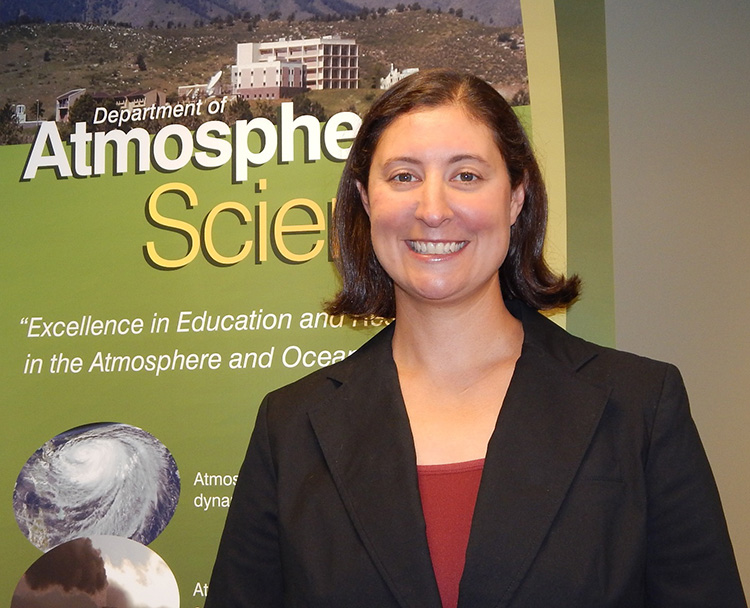
INSIGHT Into Diversity is proud to recognize women who are making a difference in the fields of science, technology, engineering, and mathematics (STEM) with the 2016 Inspiring Women in STEM Award. These women work to inspire and encourage the next generation of young people to pursue STEM education and careers via teaching, mentoring, research, and groundbreaking discoveries and innovations. As scientists, researchers, educators, entrepreneurs, and university presidents and deans, they serve as role models to students and professionals alike, emboldening them to follow in their footsteps.
As coordinator for the Front Range (FR) program at Colorado State University since 2015, Ilana B. Pollack, Ph.D., spearheads the recruitment of undergraduate women from four colleges in Colorado and Wyoming and ensures that each FR student has access to in-person mentoring with female role models through networking events at each institution. She also makes herself available to answer and address students’ and mentors’ questions and concerns.
Pollack coordinates the PROmoting Geoscience Research, Education, and Success (PROGRESS) program and the Analysis of Women’s Advancement, Retention, and Education in Science study — part of a five-year project funded by the National Science Foundation — to recruit and mentor undergraduate women in the geosciences through both formal and informal professional and peer mentoring. Via a Web platform she helped create, she ensures that PROGRESS participants have access to a variety of critical online resources: scholarship and research opportunities, information on graduate schools, peer networks, in-person mentors, and more.
More information available at insightintodiversity.com/inspiring-women-in-stem-2016
From: Inspiring Women in STEM | INSIGHT Into Diversity
August 27, 2016
Inaugural Atmos Olympics
ATS students, staff and friends of the department participated in the first ever Atmos Olympics over the weekend, an event sponsored by FORTCAST, the local AMS chapter. Team Celsius and Team Fahrenheit competed against each other in basketball, trivia, volleyball, yard games, kickball and a relay, with Team Fahrenheit ultimately prevailing. A big thank-you to all who participated and to FORTCAST for organizing this fun event!
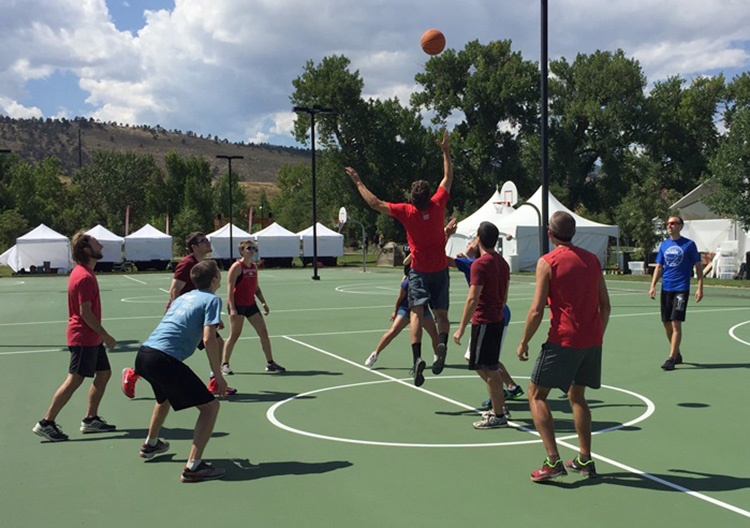
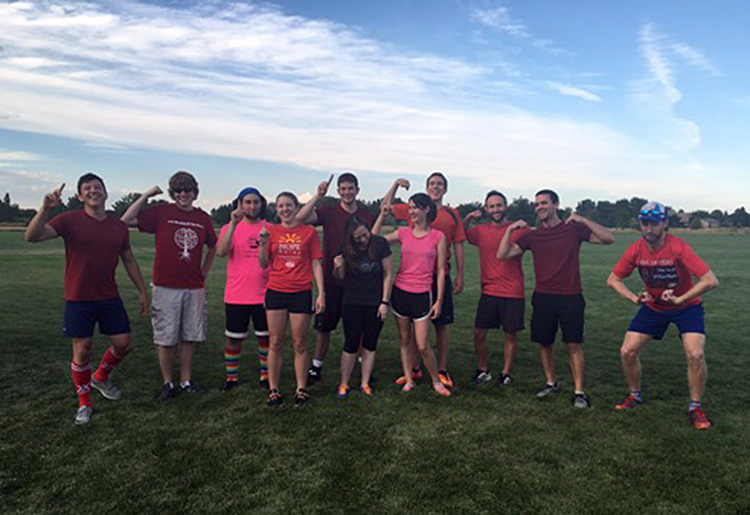
Team Fahrenheit
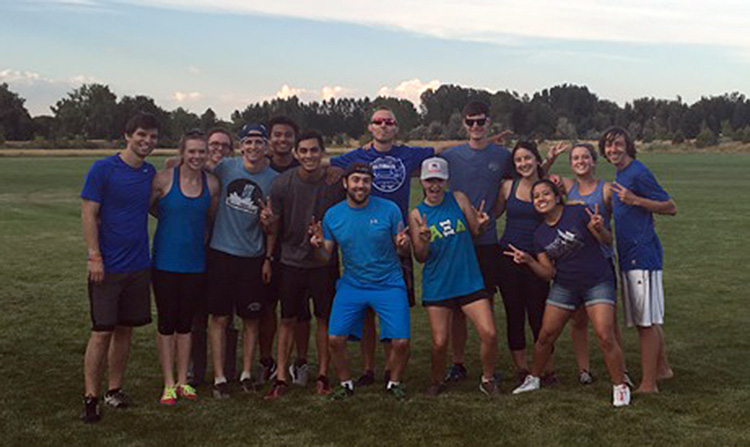
Team Celsius
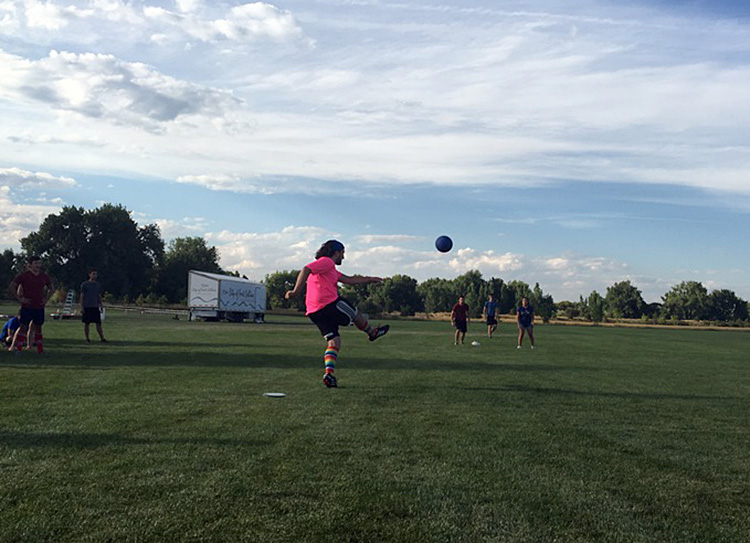
August 25, 2016
ATS Department Picnic and welcome to new atmospheric science students
On Aug. 25, the Department of Atmospheric Science held its annual Department and New Student Picnic at Spring Canyon Park in Fort Collins. This year, we invited families to attend and had live music in addition to our staples of weather bingo, yard games and a BBQ feast. This year, as in the past, faculty were introduced and in turn, they introduced their new students to the department.
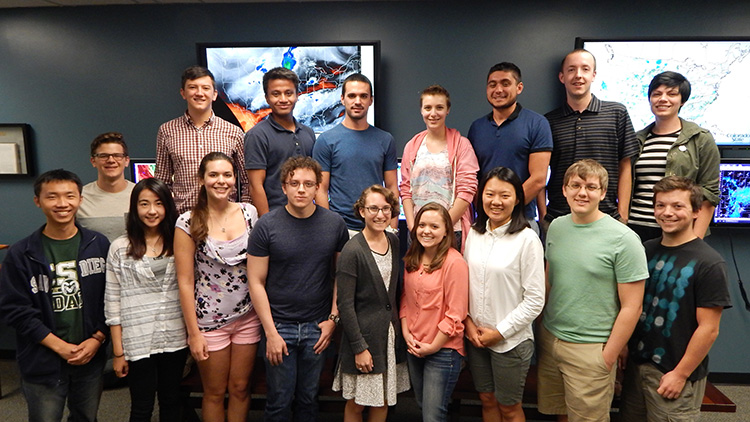
2016 new graduate students. Back row from left to right: Michael Cheeseman, Ben Toms, Naufal Razin, Jon Martinez, Bryn Ronalds, Mike Natoli, Kyle Nardi and Jennie Bukowski. Front row, from left to right: Kai-Chih Tseng, Ting-yu Cha, Ellie Delap, Luke Davis, Emily Ramnarine, Kate O’Dell, Minnie Park, Ben Trabing and Kyle Chudler

Kids enjoy live music at the department picnic.
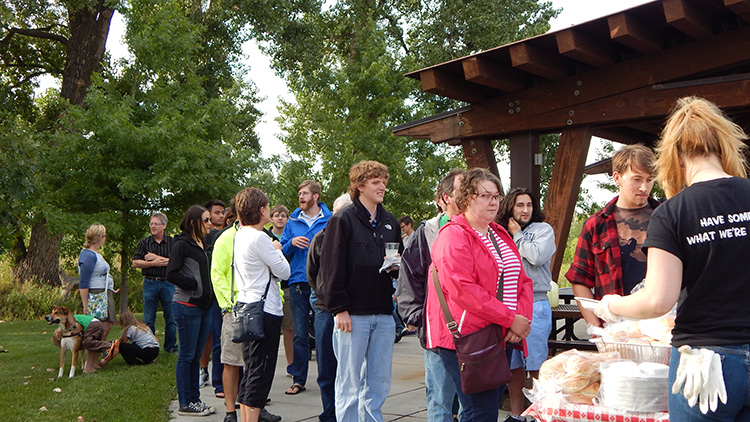
Families, students and staff line up for BBQ.
August 25, 2016
Assistant Professor Elizabeth Barnes named Outstanding Professor of the Year
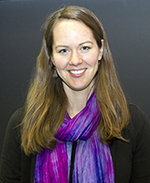
Congratulations to Assistant Professor Elizabeth Barnes for her selection as 2016 ATS Outstanding Professor of the Year. Libby’s selection was announced at the ATS picnic by graduate student representative Peter Marinescu. The Outstanding Professor award, selected by department graduate students, is awarded annually to an ATS faculty member for exemplary classroom teaching.
Congratulations, Libby!
August 19, 2016
Transfort bus route to Foothills Campus starting Aug. 22
The Foothills Campus Transfort bus service route begins Monday, Aug. 22. The first bus of the day will depart the CSU Transit Center at 7:15 a.m. and will leave once an hour until 6:15 p.m., running along Mulberry, Laporte and Overland Trail. Bus service will run Monday through Friday when CSU classes are in session. More information regarding bus stops, the route and times can be found on this Transfort map and schedule.
August 1, 2016
Ph.D. candidate Marie McGraw’s paper published as Research Spotlight in Geophysical Research Letters
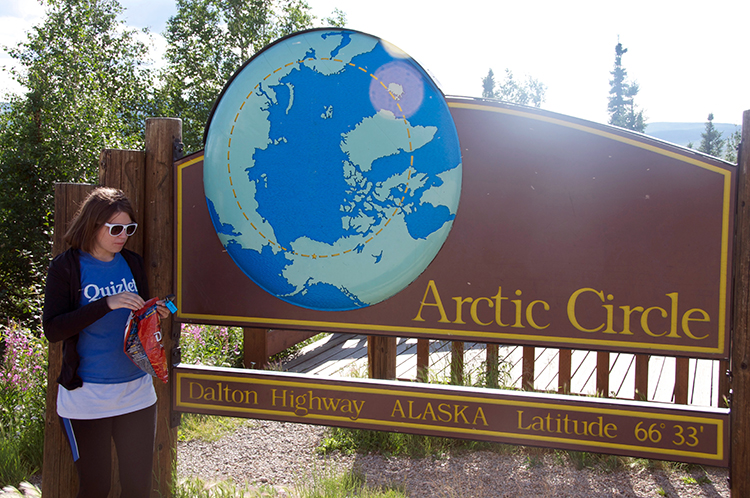
Marie McGraw at the Arctic Circle
Ph.D. candidate Marie McGraw, a member of Assistant Professor Elizabeth Barnes’ group, had a paper published and honored as a “Research Spotlight” article in Geophysical Research Letters, as well as in the AGU publication EOS.
The GRL paper, “Reconciling the observed and modeled Southern Hemisphere circulation response to volcanic eruptions,” focuses on understanding the Southern Hemisphere circulation response to large volcanic eruptions. Observations of large volcanic eruptions are limited, with studies often finding seemingly contradictory results between models and observations. In this study, Marie, Professor Libby Barnes, and collaborator Clara Deser used over 200 model simulations to fully evaluate the Southern Hemisphere circulation response to volcanic eruptions. They found that while the model mean response does not match the observed responses, the variability of the circulation response is substantial enough to explain the observations, thus demonstrating that the seeming discrepancies between the modeled and observed responses can be explained in the context of climate variability.
The department would like to congratulate Marie on this outstanding achievement!
July 26, 2016
University Distinguished Professor Emeritus Thomas Vonder Haar selected as AGU Fellow
University Distinguished Professor Emeritus Tom Vonder Haar has been selected as a 2016 Fellow of the American Geophysical Union. This special honor recognizes scientific eminence in the Earth and space sciences and acknowledges Fellows for their remarkable contributions to their research fields, exceptional knowledge, and visionary leadership. Only 0.1% of AGU membership receives this recognition in any given year. Tom will be recognized at an awards dinner at the AGU meeting this December in San Francisco.
Congratulations, Tom!
June 30, 2016
Leah Grant receives NSF GROW Award

Leah Grant, Ph.D. student of Associate Professor Susan van den Heever, has been awarded the NSF GROW (Graduate Research Opportunities Worldwide) Award. This award, only open to NSF GRFP (Graduate Research Fellowship Program) recipients, awards the winner with support for a visit to an international institution to conduct research for 2 to 12 months during their Ph.D. program. Leah will be traveling to University of Melbourne in Australia this fall to work with Dr. Todd Lane. They will investigate how changes to cold pool strengths alter characteristics of tropical convective systems in RCE, such as the convective systems’ movement, lifetime and intensity. Dr. Lane is an expert in tropical convection, coupling of atmospheric waves and convection, and mesoscale dynamics, among others.
Leah is currently investigating how convective thunderstorms and small-scale processes such as microphysics, turbulence, and surface energy fluxes interact and influence one another, using numerical modeling. Some work she has already completed toward her Ph.D. involved studying the interaction between cold pools — pools of negatively buoyant air created by precipitation evaporation and melting — and surface energy fluxes, and how this interaction changes as the cold pool evolves. She is extending this work to other environments including dry continental, tropical continental, and oceanic. She is also studying topics related to tropical convective storms in simulations of radiative-convective equilibrium (RCE), an idealized state that is commonly used to approximate the tropical atmosphere.
Congratulations, Leah, on this outstanding achievement!
June 27, 2016
ATS faculty Sue van den Heever and Eric Maloney receive AGU ASCENT awards


Two CSU ATS faculty members were just announced as winners of 2016 ASCENT awards from the Atmospheric Science section of the American Geophysical Union. Monfort Professor Sue van den Heever and Professor Eric Maloney were each selected for this distinguished recognition by AGU.
The ASCENT award recognizes exceptional research and professional leadership by mid-career scientists working in the atmospheric and climate sciences. Five ASCENT award winners were named this year: three from the U.S., one from England, and one from Australia. The award announcement was made in EOS.
Winners will receive their awards at the Atmospheric Science section dinner at the AGU meeting in December.
Congratulations to Sue and Eric on this outstanding achievement!
June 17, 2016
In memory of Dr. Elmar R. Reiter, Professor Emeritus (Feb. 22, 1928 – June 17, 2016)

Dr. Elmar Rudolf Reiter, 88, passed away June 17, 2016, in Peoria, AZ. He is survived by his spouse Gabriella Reiter, three children (Bernadette, Reinhold and Christa-Maria), and six grandchildren.
Dr. Elmar Reiter was Professor Emeritus from Colorado State University, where he helped found the Atmospheric Science Department. He was a brilliant scientist and inventor. He is best known for his work regarding “jet streams,” which gave rise to the algorithms used by airlines to determine the magnitude and direction of clear air turbulence. He was also a talented artist and tenor singer. He requested that there would be no memorial or funeral service. Instead, he wished that everyone that knew him celebrate his life. He was a scientist who contributed greatly to the advancement of climate models and weather prediction systems. The family asks that donations be given, in his memory, to scholarship funds that further scientific research at CSU school of Engineering and Atmospheric Science.
If you wish to contribute to the fund, go to advancing.colostate.edu/drelmar-reiter, call (970) 491-7135 between the hours of 8 a.m. and 5 p.m. MT, or email csugifts@csuf.colostate.edu.
Read the obituary posted in the The Coloradoan.
June 14, 2016
Garfield County air quality study results presented to public

M.S. ’14 student Bradley Wells
Data from an extensive multi-year Colorado State University study of air emissions from natural gas operations in Garfield County, Colorado have been presented publicly by a CSU research team.
Study leader Jeffrey Collett, professor and head of CSU’s Department of Atmospheric Science, presented the study results during a session of the Garfield County Board of Commissioners June 14. The presentation was streamed live and is archived on the Garfield County government website. Read the county’s news release.
The study, Characterizing Air Emissions from Natural Gas Drilling and Well Completion Operations in Garfield County, Colorado, was commissioned in 2012 by Garfield County. It was aimed at characterizing the extent of air emissions from natural gas extraction activities.
For more about this study and the results presented, read the SOURCE article by Anne Ju Manning.
June 3, 2016
Brandon Wolding selected as SoGES Sustainability Leadership Fellow

Brandon Wolding, a Ph.D. student in Professor Eric Maloney’s group, has been selected to be a 2016-17 School of Global Environmental Sustainability (SoGES) Sustainability Leadership Fellow.
SoGES Sustainability Leadership Fellows are a select group of leading CSU senior Ph.D. candidates and Postdoctoral Fellows interested in communicating their science to media and the public. Over the course of one year, these fellows receive state-of-the-art training in environmental communication and professional development skills. Fellows are selected on a competitive basis, including their current sustainability science research and their interest in communicating important scientific concepts to broad audiences.
Brandon studies a tropical phenomenon known as the Madden-Julian Oscillation. His current work seeks to improve our understanding of feedbacks between convective heating and moisture, and to anticipate how such feedbacks may change as our climate system warms. Brandon is very grateful to have the opportunity to study such an interesting problem, and to be surrounded by the talented and supportive research community at Colorado State University. He loves his job!
Congratulations, Brandon, on this outstanding achievement!
To see a list of all the 2016-17 SoGES Sustainability Leadership Fellows, read the SOURCE article.
May 23, 2016
Remembering Dr. Gray
Thank you to everyone who came to the Department’s gathering to remember Dr. Gray, to those who shared stories and remembrances, and to Bill’s children who were in attendance. Dr. Gray will be greatly missed.
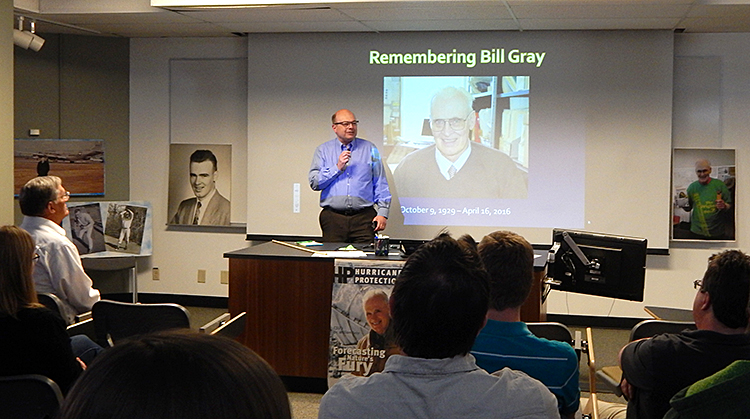
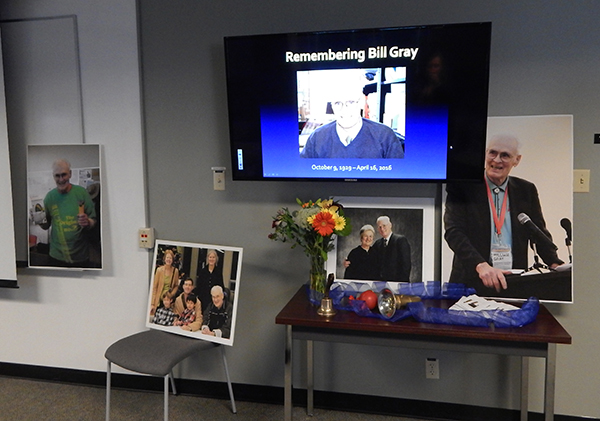
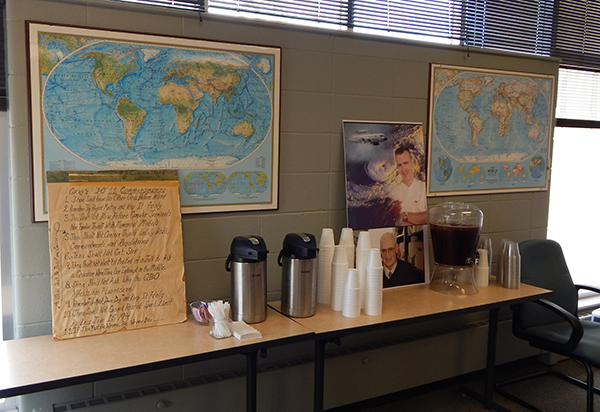
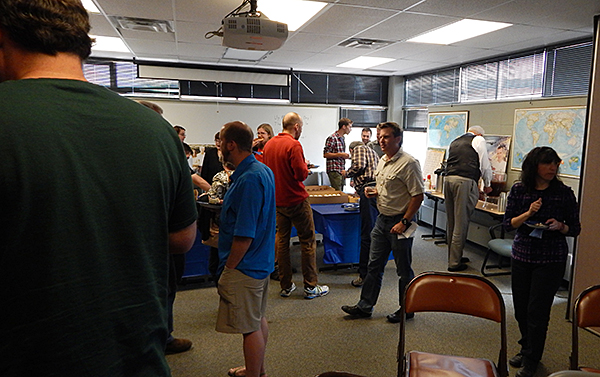
For more, view this page devoted to Dr. Gray’s career and accomplishments, written by those who knew him.
May 23, 2016
Welcome ESMEI’s Research Experiences for Undergraduates (REU) 2016 interns!

Front row, from left to right: Kevin Zolea (Kean University), Ann Casey Hughes (Wofford College), Rachel Phinney (University of Nebraska Lincoln), Rachael Coons (SUNY Albany). Back row, from left to right: Maryssa Loehr (Missouri University of Science and Technology), Steven Cavazos (University of the Incarnate Word), Anna Miller (Reed College), Khalil McMillan (North Carolina A&T State University), Alexia Prosperi (Valparaiso University), Keenan Eure (University of Maryland at College Park).
Summer is a very busy time of the year at the Earth System Modeling and Education Institute (ESMEI), the institutional legacy of CMMAP, for many reasons. One of which is the much anticipated arrival of the summer interns. ESMEI offers paid summer undergraduate research internships at Colorado State University in the Department of Atmospheric Science. Interns participate in a 10-week program from late May through July. This is an exciting research opportunity in beautiful Fort Collins, Colorado, where they join world-class atmospheric scientists investigating the science of clouds, climate and climate change, weather, and modeling. During the Research Experiences for Undergraduates (REU) program, interns have the opportunity to attend scientific seminars, visit national scientific laboratories, and participate in a variety of professional development training.
May 17, 2016
ATS and CIRA named CSU Program of Research and Scholarly Excellence

ATS Foothills Campus 4/25/16 (Photo credit: Katie Oldberg)
We are pleased to announce that the Department of Atmospheric Science and CIRA have been jointly designated as a CSU Program of Research and Scholarly Excellence (PRSE). Atmospheric Science has been repeatedly designated as a PRSE since the program’s inception in 1991. CIRA and ATS were jointly designated in 2012 and have now been re-designated as a PRSE for the next four years.
PRSE selection is a competitive process open to programs across campus. This year’s ATS/CIRA designation is the result of a successful proposal submitted earlier this year. Our selection reflects the many collective accomplishments of ATS and CIRA faculty, staff, and students — and our broader collaborators at CSU and beyond — over the past 5 years. PRSE designation comes with award of a graduate student fellowship from the Graduate School and an opportunity to compete for other funding from the office of the Vice President for Research.
Thanks to all that each of you do to make atmospheric science research and graduate education at CSU so successful. We look forward to continued synergy in the partnership between ATS and CIRA as we tackle the many compelling scientific challenges in our field.
—Professor and Department Head Jeff Collett and Professor and CIRA Director Chris Kummerow
May 13, 2016
Congratulations Spring 2016 Atmos Graduates!
Congratulations go out to our recent Department of Atmospheric Science Graduates and Ph.D. Candidates, several of whom walked in commencement ceremonies Friday, May 13.
The department recognizes their dedication to science and research and is proud of their academic achievements. Graduation brings new and varied opportunities and there is no doubt that success awaits them in their future endeavors.
Spring 2016 Graduates:
| Ali Boris* | Ph.D. | Advisor: Jeff Collett |
| Melissa Burt | Ph.D. | Advisor: Dave Randall |
| Michal Clavner | Ph.D. | Advisor: Bill Cotton |
| Aryeh Drager* | M.S. | Advisor: Sue van den Heever |
| Peter Goble | M.S. | Advisor: Russ Schumacher |
| Alex Goodman* | M.S. | Advisor: Dave Randall |
| Greg Herman | M.S. | Advisor: Russ Schumacher |
| Noel Hilliard* | M.S. | Advisor: Jeff Collett |
| Leah Lindsey* | M.S. | Advisor: Dave Randall |
| Andy Manaster | M.S. | Advisor: Chris O’Dell/Chris Kummerow |
| Peter Marinescu | M.S. | Advisor: Sue van den Heever |
| Alex Naegele* | M.S. | Advisor: Dave Randall |
| Erik Nielsen | M.S. | Advisor: Russ Schumacher |
| Amanda Sheffield | Ph.D. | Advisor: Sue van den Heever |
| Doug Stolz | Ph.D. | Advisor: Steve Rutledge |
| Liz Thompson | Ph.D. | Advisor: Steve Rutledge |
| Jake Zaragoza | M.S. | Advisor: Emily Fischer |
*Anticipated graduation summer 2016
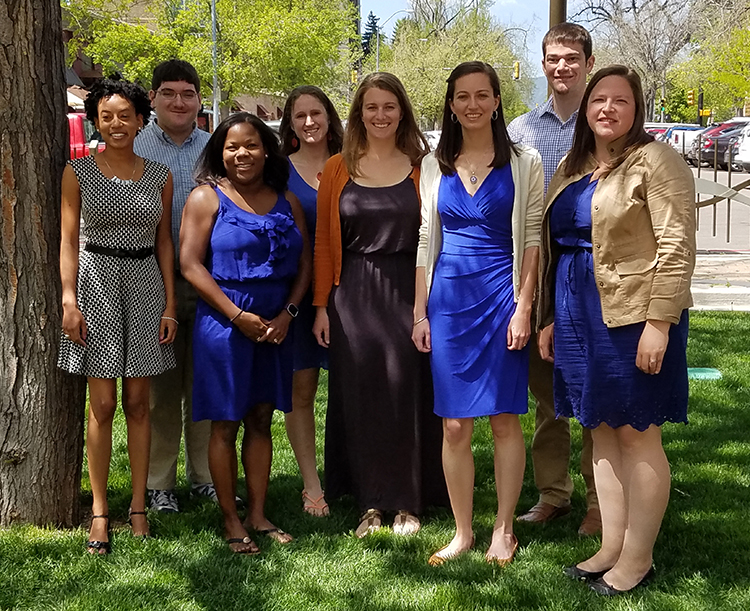
Left to right: Noel Hilliard, Aryeh Drager, Melissa Burt, Ali Boris, Alex Naegele, Adele Igel, Erik Nielsen, Amanda Sheffield
May 9, 2016
Yi Li leads new PNAS publication examining shifts in oxidized and reduced nitrogen deposition in U.S.
On May 9 recent Ph.D. graduate Yi Li, advised by Professor and Department Head Jeff Collett, published a paper in the Proceedings of the National Academy of Sciences (PNAS), “Increasing importance of deposition of reduced nitrogen in the United States.”
It is unusual for a grad student to lead a paper in PNAS. Congratulations Yi, on this outstanding achievement!
To read more about this high-impact paper, please read the CSU SOURCE article, “Agricultural ammonia emissions disrupt earth’s delicate nitrogen balance” by Anne Ju Manning.

May 6, 2016
Thomas C. Peterson receives 2016 CSU Atmospheric Science Distinguished Alumni Award
Dr. Thomas C. Peterson (Tom) received the 2016 CSU Department of Atmospheric Science Distinguished Alumni Award from Department Head Jeff Collett on May 6. This award is presented to an outstanding alumnus and/or alumna who exemplifies core values revered by the department including dedication to research, commitment to education, and leadership prowess in the atmospheric sciences. These values, exemplified throughout the course of Thomas’ distinguished career, are the very reason he was chosen for this award.
Tom Peterson is the President of the World Meteorological Organization’s Commission for Climatology. In 2004 Essential Science Indicators ranked him as one of the top 1% of scientists in the field of Geosciences based on Journal Citation Reports. He was a lead author on the Nobel Peace Prize-winning Intergovernmental Panel on Climate Change’s Fourth Assessment Report published in 2007. Foreign Policy Magazine named him one of the top 100 Leading Global Thinkers of 2013 for his work on Explaining Extreme Events from a Climate Perspective. In July Dr. Peterson retired from his position as Principal Scientist at NOAA’s National Centers for Environmental Information.
In addition to receiving this award, Tom gave a special colloquium presentation, “The Story of Climate Data,” during the award ceremony.
The department would like to congratulate Tom on his career achievements and thank him for proudly representing CSU over the years.
SM.jpg)
Tom Peterson receives award from Jeff Collett

Jeff Collett and Tom Peterson

2016 Alumni Award recipient Leah Grant and 2016 Distinguished Alumni Award recipient Tom Peterson

Student volunteers, back row, from left to right: Stacey Hitchcock, Adele Igel, Aryeh Drager, Leah Grant, Sam Childs, Peter Marinescu, Erik Nielsen, Casey Patrizio, Justin Whitaker, Zitely Tzompa. Front row, left to right: Rick Schulte, Anna Hodshire, Will Lassman, Jakob Lindaas
And a big thank-you and shout-out to our student volunteers. We could not have had a successful year without you!
May 6, 2016
Jack Kodros and Leah Grant receive department honors


Congratulations goes out to M.S. student Jack Kodros and Ph.D. candidate Leah Grant for receiving distinguished honors this week at the annual CSU Department of Atmospheric Science Herbert Riehl Memorial Award/Alumni Award Ceremony held on May 6.
The 2016 Riehl Award for an outstanding paper based on M.S. research went to Jack Kodros. Jack, advised by Associate Professor Jeff Pierce, won for his recent Atmospheric Chemistry and Physics paper, “Uncertainties in global aerosols and climate effects due to biofuel emissions.” Jack was unable to attend the ceremony. We will look for an opportunity for Jack to present his paper in the near future.
The 2016 Alumni Award for an outstanding paper based on Ph.D. research went to Leah Grant. Leah is advised by Associate Professor Sue van den Heever. She was recognized for her recent Journal of Geophysical Research (JGR) paper, “Cold Pool Dissipation.” Leah gave a great presentation that stimulated a great deal of discussion. Leah is now the third ATS student to be selected for both the Riehl and Alumni student paper awards, following Angela Rowe and Adele Igel.
Both of these awards are based on faculty nominations and a committee decision. The Herbert Riehl Memorial Award is awarded to a current M.S. candidate or a student in the Ph.D. program for less than one year. The student must have obtained their M.S. degree from our Department and have submitted a technical manuscript for publication during the previous 18-month period. The Alumni Award is given to a senior Ph.D. candidate who has passed the preliminary exam and has submitted at least one paper to the peer-reviewed literature based on their dissertation work.
The department would like to congratulate Jack and Leah again for their hard work and recognize them for their outstanding achievement.
April 27, 2016
Ben Toms awarded 2016 American Meteorological Society Graduate Fellowship

Ben Toms, an incoming fall 2016 M.S. student in Associate Professor Susan van den Heever’s group, has been awarded a 2016 American Meteorological Society Graduate Fellowship. The AMS Fellowship Program is a source of scholarships, useful resources, and unique opportunities for outstanding students looking to pursue graduate education in the atmospheric or related sciences. To date, 339 students have been designated as AMS fellowship recipients. The program helps these first-year graduate students to be educated about unique challenges facing the world so that they may better tackle these real-world issues after graduation. Fellowships come with several benefits that include financial support to maintain a full course load over their first year of graduate study, the opportunity to be special guests at the AMS Annual Meeting with exclusive events therein, ongoing academic and career advocation, and support from AMS.
During Ben’s undergraduate research activities, he developed a Python-based black ice prediction model for the state of Oklahoma and studied atmospheric gravity waves using ground-based remote sensing instruments. Ben is currently working on a project studying the impacts of climate change on wildfire plume dispersion within the Intermountain West, and hopes to be able to apply some of this work to his research at the Department of Atmospheric Science. While not yet placed on a specific project within the van den Heever group, Ben hopes to work with aerosol interactions with convection and how that might play a role in extratropical cyclone development.
Congratulations, Ben!
April 20, 2016
Join us for ribbon-cutting ceremony for new GOES-R antenna

Please join us Monday, April 25, 2:30 p.m. for a ribbon-cutting ceremony for the new Geostationary Operational Environmental Satellites – R series (GOES-R) antenna. VPR Alan Rudolph, Dean McLean, Dept. Head Jeff Collett, Greg Mandt (GOES-R program manager) and Steve Goodman (GOES program scientist) will do the honors. There will be light refreshments in the Cooperative Institute for Research in the Atmosphere (CIRA) building following the ribbon cutting.
From the GOES-R website:
The GOES-R is the next generation of geostationary weather satellites. There are four satellites in the series: GOES-R, GOES-S, GOES-T and GOES-U. The first satellite in the series, GOES-R, is scheduled for launch in October 2016. The GOES-R Series Program is a collaborative development and acquisition effort between the National Oceanic and Atmospheric Administration (NOAA) and the National Aeronautics and Space Administration (NASA) to develop, launch and operate the satellites.
The GOES-R series satellites will provide continuous imagery and atmospheric measurements of Earth’s Western Hemisphere, total lightning data, and space weather monitoring to provide critical atmospheric, hydrologic, oceanic, climatic, solar and space data.
To read more about GOES-R, please visit the GOES-R website.
April 18, 2016
Save the date! Herbert Riehl, Alumni, and Outstanding Alumni Award Ceremony May 6

April 16, 2016
In Memory of Professor Emeritus William Gray

William Mason Gray (Bill) passed away peacefully surrounded by his family on April 16, 2016, at the age of 86. With his passing, the meteorological community has lost one of its most remarkable members. Bill was a faculty member in the Department of Atmospheric Science at Colorado State University from 1961 until his retirement in 2005. His research made enormous contributions to the understanding of tropical cyclone structure, intensification, and climatology. During his long academic career Bill advised 70 master’s and Ph.D. students, many of whom have become prominent leaders in the field of tropical meteorology.
To continue reading, please see the page devoted to Dr. Gray’s career and accomplishments.
April 6, 2016
CSU Atmospheric Science professors awarded EPA grant to study wildfire effects

Emissions of wildfire smoke and dust likely will increase over the western U.S. with climate change. However, we don’t know exactly how the climate will change. There are many possible futures. A team of researchers from the Department of Atmospheric Science (principal investigator Assistant Professor Emily Fischer) is going to propagate the uncertainty in future meteorology to an uncertainty in future smoke and dust concentrations. The team, which includes co-investigators Assistant Professor Jeffrey Pierce and Assistant Professor Elizabeth Barnes, along with Emily Fischer’s M.S. student Steven Brey, has a goal to do this by EPA region, so they can have a full view of the possible air quality implications of more fires and dust storms in the future. Their research will be funded by a three-year, $350,000 grant awarded by the Environmental Protection Agency (EPA).
Read the CSU SOURCE article about this grant, “Smoke, dust and unknown future: CSU researchers to study wildfire effects.”
March 28, 2016
Zitely Tzompa receives Rocky Mountain States Air and Waste Management Association Scholarship

Ph.D. student Zitely Tzompa, a member of Assistant Professor Emily Fischer’s group, was awarded a scholarship by the Rocky Mountain States Section of Air and Waste Management Association (RMSS-A&WMA). Along with the scholarship, Zitely will receive a one-year student AWMA membership. The Air & Waste Management Association (A&WMA), a nonprofit organization, provides a forum for the exchange of information in a neutral forum. Its mission is to support professional development, networking, outreach and public information in more than 65 countries. A&WMA promotes global environmental responsibility and increases the effectiveness of organizations to make critical decisions that benefit society.
Zitely is investigating emissions of ethane from conventional and unconventional oil and natural gas extraction. The goal of this study is to update the global ethane budget based on the recent changes in emissions distributions caused by the massive growth of shale gas exploitation in North America. The ultimate goal of Zitely’s research is to examine the regional lower tropospheric ozone enhancements due to the oil and natural gas industry emissions of these alkanes.
Congrats, Zitely!
March 15, 2016
Emily Riley Dellaripa receives Editors’ Citation for Excellence in Refereeing – JGR-Atmospheres

Emily Riley Dellaripa, a postdoc with Associate Professor Susan van den Heever’s group and Professor Eric Maloney’s group, will receive the 2015 Editors’ Citation for Excellence in Refereeing for JGR-Atmospheres. One of the most important services performed for AGU (American Geophysical Union) is the conscientious reviewing of submitted papers. Because of the nature of the reviewing process, this service is also one of the least recognized. The purpose of this citation is to express publicly the gratitude of AGU to those whose reviews have been particularly commendable. Emily’s contributions to the journals program have been invaluable in maintaining a high quality standard. An announcement is planned for publication in a future issue of EOS (Earth & Space Science News).
Emily’s research interests are in tropical meteorology with a focus on the Madden-Julian Oscillation, mesoscale organization and its role in multi-scale interactions, and convective initiation and growth. These interests are motivated by an overarching goal to better understand moist tropical convection and its role in larger-scale circulations. Observations, both space based and ground based, along with cloud resolving models are used in her research.
Congratulations, Emily!
March 4, 2016
FORTCAST to host Dr. Laura Sample McMeeking

FORT Collins Atmospheric ScientisTs (FORTCAST) is hosting Dr. Laura Sample McMeeking for our March chapter meeting on Wednesday, March 30, 2016. This event is free and open to the public. Food and beverages will be provided.
Please RSVP if possible so FORTCAST can plan accordingly for food and beverages. RSVP here.
Who: Dr. Laura Sample McMeeking
When: Wednesday, March 30, 2016, 6:30 pm
Where: Colorado State University, Behavioral Sciences Building, Room 103
BIO: Laura Sample McMeeking is the Associate Director of the CSU STEM Center. From early in her life in Texas, Laura was fascinated with weather, which led her to Texas A&M for her undergraduate degree in Meteorology. It was during her undergraduate studies and later her graduate studies in atmospheric science at Colorado State University that Laura first became interested in not only how we study weather (or in her case atmospheric aerosols) but also how we talk about our research with others and teach them about our science. It was difficult not to think about how we communicate, having grown up in an extended family of attorneys and teachers. The many discussions Laura had with her family and friends prompted her to start asking questions about how people learn, and particularly how we, as scientists and educators, can get others as excited about weather and atmospheric science as we are. So, she successfully completed her Ph.D. in Education Research at Colorado State and has since walked along the border of atmospheric science and education in her own research. Now, as well as being an administrator in the STEM Center, Dr. Sample McMeeking studies how teachers, undergraduates, graduate students, and faculty learn new knowledge and skills through professional development. Her research necessarily focuses on how different groups communicate to teach and learn from each other.
February 14, 2016
Dr. Eugene A. Mueller, radar pioneer, passes away

Dr. Eugene A. Mueller, one of the original engineers of the CHILL research weather radar system, passed away on Feb. 14, 2016. He made significant contributions to the field of radar meteorology over a span of four decades. At CSU Gene oversaw the continuing technical advancement of the radar (now known as CSU-CHILL). Notable radar improvements made at CSU included the adaptation of a dual transmitter configuration in which separate, identical transmitters were used to generate the horizontally and vertically polarized signals. Gene also developed the specifications for the custom-built dual polarization antenna that was acquired in 1994. He retired from his position as CSU-CHILL radar senior engineer in July 1995 and continued to live at his home in Loveland, Colorado.
Gene will be missed as both a mentor as well as a friend.
Please see the page devoted to Dr. Eugene A. Mueller’s career and accomplishments written by Senior Research Associate Pat Kennedy and Professor Steven Rutledge.
February 12, 2016
Karly Reimel breaks CSU women’s track indoor pole vault record, twice

Karly Reimel, first-year graduate student with Professor Steven Rutledge’s group, set a new Colorado State University women’s track indoor pole vault record, twice! Karly first broke the record on Jan. 23 at the University of Nebraska at 3.93m (12’10.75″). A week later on Jan. 30 at the University of New Mexico, she broke her own record at 4.05m (13’3.5″). Karly, who competed for three seasons at Florida State University, is using her last year of eligibility to compete for CSU. CSU sure likes her being on the team, for obvious reasons!
For her M.S., Karly is researching the relationship between lightning and severe weather in an attempt to better understand how lightning can be used to better predict the onset of severe weather.
Congratulations, Karly!
February 10, 2016
Department Head Jeff Collett appointed to USDA Agricultural Air Quality Task Force

Department Head Jeff Collett has been appointed by the U.S. Secretary of Agriculture to serve on the USDA Agricultural Air Quality Task Force. The task force, originally formed in 1996 at the direction of Congress, advises the Secretary of Agriculture on air quality and its relationship to agriculture based on sound scientific findings. Jeff will serve a 2-year term.
Congratulations, Jeff!
Read the SOURCE article
February 4, 2016
Jakob Lindaas receives Outstanding Student Platform Presentation Award

Please join the department in congratulating M.S. student Jakob Lindaas, advised by Assistant Professor Emily Fischer, for receiving an Outstanding Student Platform Presentation Award at the 96th American Meteorological Society (AMS) Annual Meeting in New Orleans. Jakob’s award was from the 18th AMS Conference on Atmospheric Chemistry for his presentation based on previous research at Harvard University.
Based on work Jakob did under the guidance of Professor Steve Wofsy and Dr. Roisin Commane at Harvard University, his talk, “Empirical Estimates of Alaskan Net Ecosystem Exchange,” aimed to answer the question: Is Alaska a net sink or source of carbon dioxide to the atmosphere? Jakob and his colleagues used in situ CO2 data collected during 2012-14 aboard the NASA C-23 Sherpa aircraft during the NASA Carbon in Arctic Reservoirs Vulnerability Experiment (CARVE) campaign. They used a data assimilation approach to constrain a simple biogenic model of the net flux and determined that the biosphere of Alaska was a net source of carbon dioxide in 2013 and 2014, and was net neutral (neither a sink or a source) in 2012. Taking into account carbon dioxide emitted by humans and wildfires, Alaska became an even bigger source of CO2 in 2013 and 2014.
February 3, 2016
Peter Marinescu receives Outstanding Student Presentation Award

Congratulations to M.S. student Peter Marinescu, co-advised by Monfort Professor Sue van den Heever and University Distinguished Professor Sonia Kreidenweis, for receiving an Outstanding Student Presentation Award at the 96th Annual American Meteorological Society Meeting in New Orleans, LA. Peter’s presentation, “Impacts of Vertically Varying Aerosol Layers on MCS Cold Pool and Precipitation Processes,” was part of the Eighth Symposium on Aerosol–Cloud–Climate Interactions at the AMS meeting. In this presentation, Peter demonstrated using the Regional Atmospheric Modeling System (RAMS) that both aerosol particles in the lower troposphere and middle troposphere can impact the cloud microphysics and precipitation within the mesoscale convective systems.
Congrats, Peter!
January 7, 2016
Reception for alumni, faculty, students and friends at 96th AMS Meeting

January 6, 2016
Leah Grant receives Outstanding Student Paper Award at AGU Fall Meeting

Sahara desert MODIS true-color image
Please join the department in congratulating Monfort Professor Susan van den Heever’s Ph.D. student Leah Grant for receiving an Outstanding Student Paper Award for her presentation on cold pools at the 2015 American Geophysical Union (AGU) Fall Meeting. Leah’s talk, “Cold Pool and Surface Flux Interactions in Different Environments,” focused on a specific question: how do surface sensible heat fluxes impact evolution of convective cold pools? There are two main mechanisms for sensible heat fluxes to influence cold pools: by heating the cold pool directly and modifying its negative buoyancy; and by changing turbulent entrainment of environmental air into the cold pool. Leah and Monfort Professor van den Heever evaluated these two mechanisms using a suite of simulations of idealized, isolated cold pools. Their simulations were ideally representative of dry continental conditions that have large sensible heat fluxes, such as the cold pools over the Sahara desert in the MODIS true-color image.
Congratulations, Leah, on this outstanding achievement!



